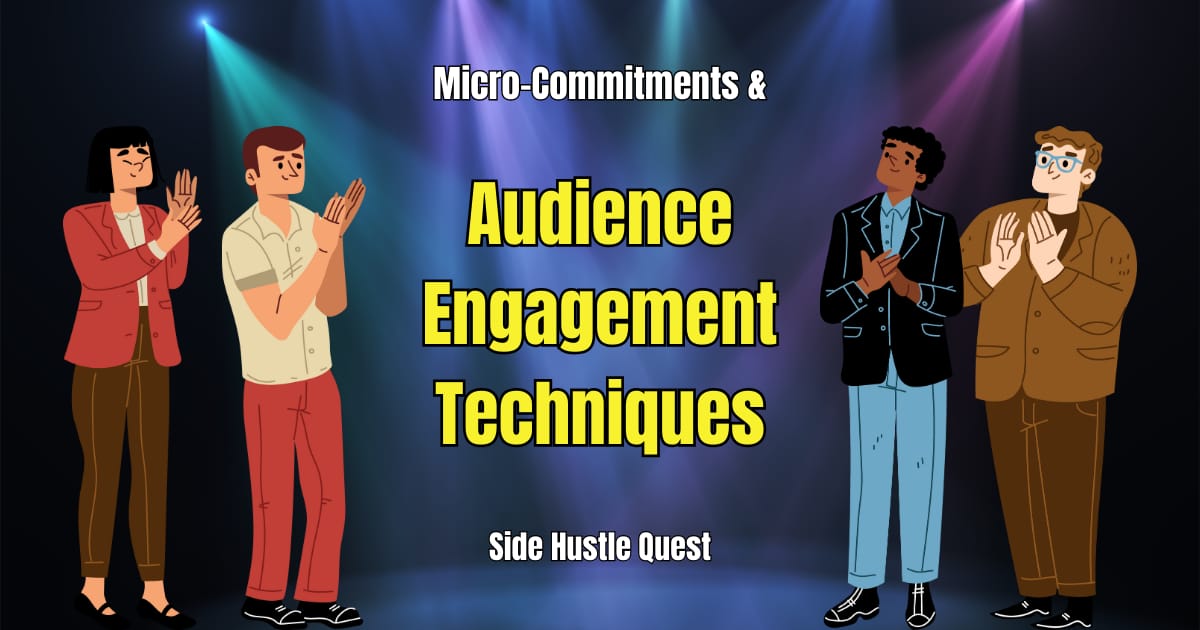Disclaimer: This article is for informational purposes only and does not constitute professional advice.

Decorative title with four caricatures clapping.
Hey there, fellow side hustler!
In today’s fast-paced digital landscape, capturing and maintaining the attention of your audience is a challenge faced by entrepreneurs across industries. As attention spans shrink, the need for innovative engagement strategies has never been more critical. Enter the concept of micro-commitments. By leveraging bite-sized actions, entrepreneurs can draw their audience in, encourage meaningful interactions, and ultimately drive macro-results for their businesses.
Understanding Micro-Commitments
Micro-commitments are small, incremental actions that encourage users to engage with your product, service, or content. These commitments are often low-risk and easy to fulfill, which lowers the barrier for participation. Examples include subscribing to a newsletter, participating in a poll, or even downloading a free resource. The goal is to create a series of small steps leading to a more significant commitment over time.
Why Micro-Commitments Matter
Building Trust: Micro-commitments foster a sense of loyalty. When users take small actions and experience positive outcomes, they are more likely to develop trust in your brand. This is crucial for long-term engagement and customer retention.
Reducing Resistance: Engaging users with manageable actions minimizes the perceived effort and risk involved in participating. This is particularly beneficial when introducing new concepts or products.
Gradual Buyer Journey: Micro-commitments help guide potential customers through the buyer journey, moving them from awareness to consideration, and eventually to conversion.
Insights and Feedback: Each micro-commitment can provide valuable insights into your audience’s preferences and behaviors. This data allows for better targeting and improved offerings.
Strategies for Implementing Micro-Commitments
✅ Start with Simple Actions: Begin with low-hurdle engagements that require minimal time and effort. For instance, inviting users to answer a quick question or watch a short video can significantly increase interaction rates.
✅ Create Value: Ensure that each micro-commitment offers value to the user. Whether it's insightful content or useful tools, the perceived benefit must outweigh the effort to engage.
✅ Use Clear Calls-to-Action (CTAs): Employ strong, action-oriented CTAs that clearly convey what you want your audience to do next. Phrases like "Join Our Community" or "Get a Free Sample" are effective and compelling.
✅ Leverage Social Proof: Showcase testimonials and success stories to diminish hesitance. When potential customers see that others have benefited from similar micro-commitments, they are more likely to engage themselves.
✅ Create a Commitment Ladder: Develop a structured path of micro-commitments that gradually leads to larger behaviors. For example, start with a simple subscription to your email newsletter, followed by exclusive content access, and eventually, an invitation to a paid webinar.
✅ Automate and Personalize: Utilize marketing automation tools to manage follow-ups and nurture relationships based on user behavior. Tailoring communications based on previous actions enhances user experience and engagement.
✅ Measure and Optimize: Continuously track the success of your micro-commitments. Analyzing metrics such as click-through rates, engagement levels, and conversion rates will help you refine your strategy over time.
From Micro-Commitments to Macro-Results: Case Studies
Several successful corporations have effectively harnessed micro-commitments, and their results speak volumes.
Dropbox: The cloud storage service famously grew its user base via a referral program, presenting users with micro-commitments to invite friends in exchange for additional storage space. This strategy resulted in a massive user increase, showcasing the effectiveness of micro-commitments.
Zocdoc: The healthcare appointment scheduling service encouraged users to book simple appointments online. Initially, they asked users to fill out a short questionnaire about their health, which resulted in high engagement and a greater number of booked appointments.
HubSpot: By offering free resources and tools, HubSpot captured leads with minimal commitment. Users could access e-books and reports in exchange for their email addresses, leading to a robust nurturing process that resulted in significant conversion rates.
In A Nutshell
Mastering the art of micro-commitments is indispensable for modern entrepreneurs. By breaking down engagement into manageable actions, you can cultivate a loyal audience base and drive substantial results. Whether through building trust, reducing resistance, or providing valuable insights, the impact of micro-commitments reverberates throughout all stages of the customer journey.
As you refine your approach, remember that every micro-commitment is a stepping stone toward achieving macro-results in your entrepreneurial endeavors. Embrace this strategy to not only captivate your audience but to also fuel your long-term success.
Thanks for reading.
References:
Cialdini, R. B. (2009). Influence: Science and Practice. Pearson Education.
Fogg, B. J. (2009). A Behavior Model for Persuasive Design. Proceedings of the 4th International Conference on Persuasive Technology.
Kotler, P., & Keller, K. L. (2016). Marketing Management. Pearson Education.
❣️ Did you like this article? Please like and share. 📥️ Not yet subscribed? Get the newest SideHustle.Quest articles delivered to your inbox at no cost.